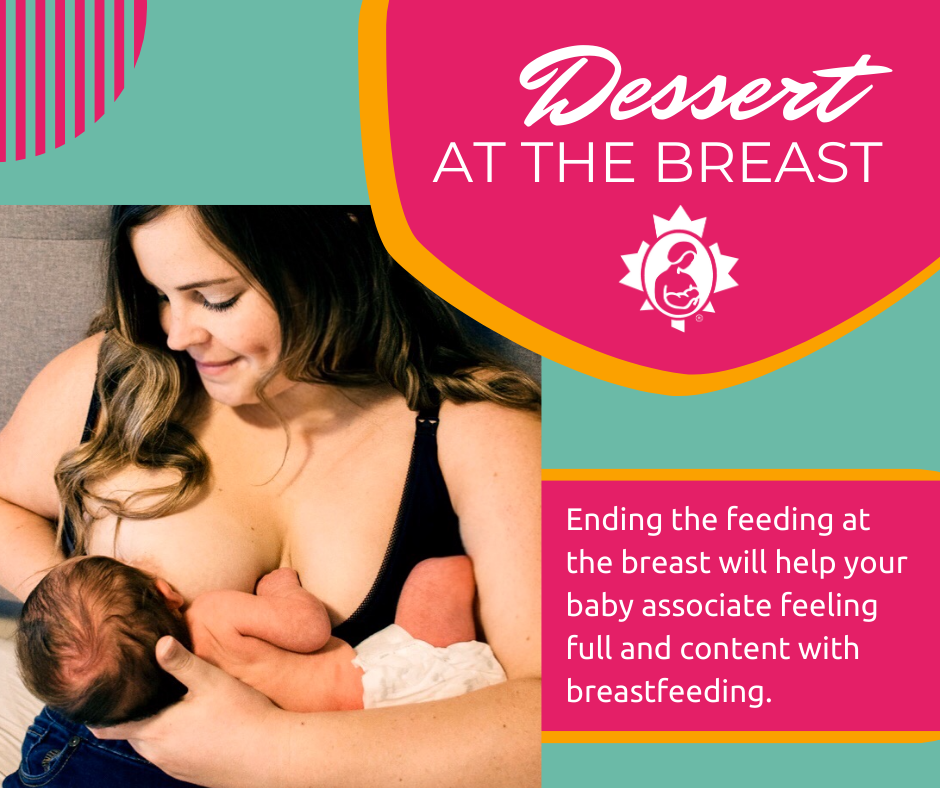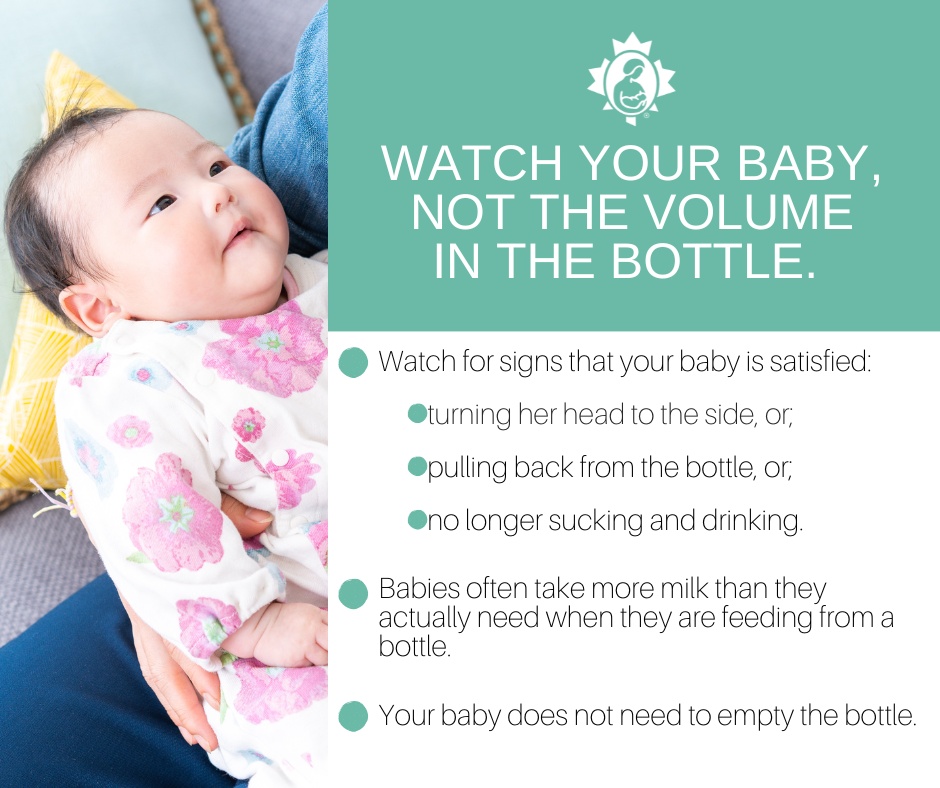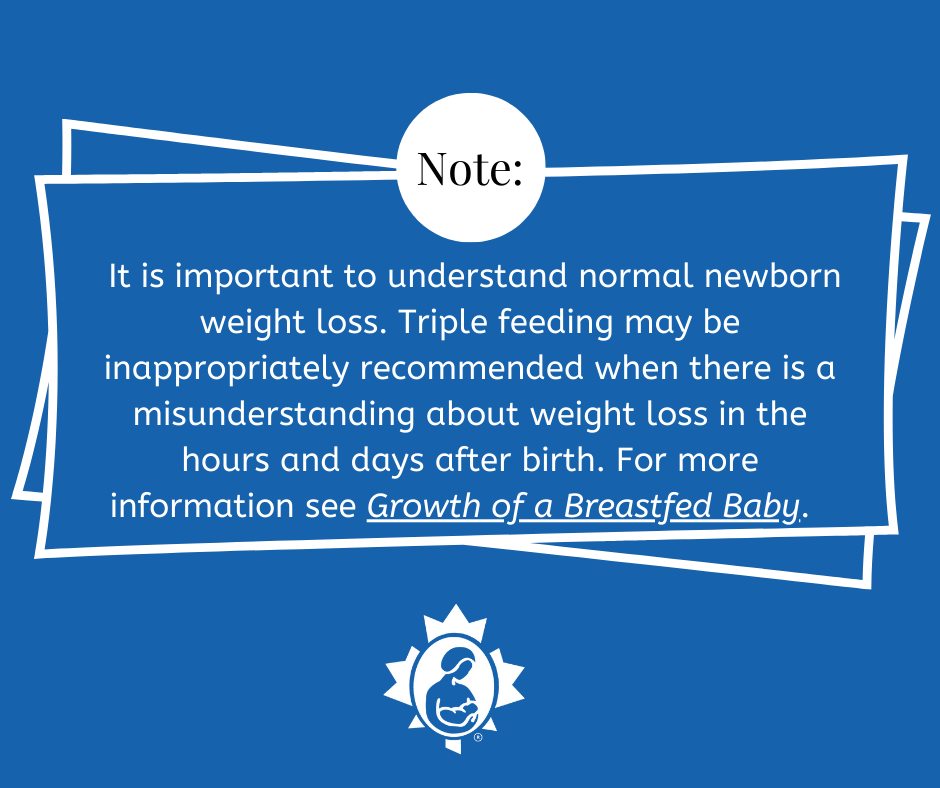
What is triple feeding?
- It is a short term plan to increase your milk production while making sure your baby is getting enough to eat. If you think you need to increase milk production see Low Milk Production for more information.
- At every feeding you are:
~directly feeding from the breast;
~supplementing with expressed milk (and sometimes additional formula) by bottle, syringe, spoon or cup;
~and, pumping or hand expressing for the next feed. - You may be triple feeding for:
~a baby born prematurely and just starting feedings at the breast;
~a baby born at 37-39 weeks gestation (late preterm) who is not getting enough milk from direct breastfeeding;
~or, an older baby who has not been feeding well or has stopped gaining or has lost weight.
Deal with Pain
If your nipples are damaged and sore, it is important to deal with the pain by finding the cause.
Common causes include:
- a shallow latch
~A baby with a shallow, painful latch is not able to remove milk effectively from the breast.
~See Positioning and Latching for more information on achieving an effective and comfortable latch.
~Or contact a La Leche League Leader or International Board Certified Lactation Consultant (IBCLC) for support. - pumping issues - These may include:
~a poorly fitted pump flange;
~pump vacuum setting is too high; or,
~not lubricating the flange before pumping.
~See Pump Fit Matters for more about pumps and comfort. - See Nipple Pain for more information and other possible causes.
Tips for transitioning to feeding exclusively at the breast
Offer any supplement in a way that protects breastfeeding
- Option 1 - Paced bottle feeding:
~allows your baby to be more in control of the feeding;
~slows down the flow of milk, so your baby can feed slower and take breaks.
~helps prevent overfeeding, which is common with bottle feeding.
~helps prevent your baby from expecting a fast, steady flow of milk from your breast. - Option 2 - Cup, spoon or syringe:
~Transitioning from a bottle to cup feeding may be helpful.
~Using a different feeding method may prevent your baby from being frustrated or confused by the change from your soft breast and nipple to a stiff, firm bottle nipple.
~For more information see Cup Feeding 1-2-3. - Option 3: At-breast supplementer system:
~Supplementing at the breast means your baby spends more time at the breast, which helps to increase your milk production. - For additional information see How to Protect Breastfeeding While Supplementing.
Offer supplement before or after breastfeeding
- Option 1 - Start at the breast and then offer the supplement:
~Put your baby to the breast and allow her to feed until she stops swallowing regularly.
~Offer the expected amount of supplement by paced bottle feeding, at-breast supplementer, breast, cup or spoon.
~If your baby is willing, put her back to the breast to end the feeding. - Option 2 - Use the "Finish at the Breast" Method of supplementation:
~Offer a limited amount (less than a full feeding) of supplement with the bottle, then offer the breast. Your baby may be more patient and calm at the breast with some milk from the bottle in her belly at the beginning of the feeding.
~End the feeding at the breast. This will help your baby associate feeling full and content with breastfeeding, rather than bottle feeding. Think 'dessert at the breast'.
~Know that it may take several feedings to determine how much supplement to give by the bottle.

Get more milk from breast to baby
- Use breast compressions when breastfeeding to keep the milk flowing. This increases the amount of milk your baby drinks from the breast. It encourages your baby to continue sucking and helps to increase your milk production.
- Switch sides often for young babies to keep the milk flowing. This can also keep them interested and alert.
- See Breast Compressions and ‘Switch Nursing’.
Provide non-feeding opportunities at breast
Any time at the breast is helpful for increasing milk production and your baby’s intake.
- Add “extra”, short, at-breast feeds (snacks), especially at night. Removing milk from your breasts at night is important for your milk supply.
- Try co-sleeping with your baby’s bed beside yours or bedsharing. Bedsharing can make the transition to exclusive breastfeeding easier for you and your baby. See Safe Sleep Seven for information on safe bedsharing.
- Eliminate pacifier use whenever possible. Encourage your baby to nurse often, including for comfort and for sleep.

Reduce supplementation gradually
- As your baby increases the amount of feeding at the breast, gradually reduce the amount of expressed milk or formula you give to your baby. This way you will see gradual progress to your endpoint of exclusive breastfeeding!
- Consult your healthcare provider or an International Board Certified Lactation Consultant (IBCLC) on how much to reduce the volume of expressed milk or formula you give per day.
- Once your baby is breastfeeding well, your plan may include
~Reducing the amount of supplement in the supplementary feeds by 8-15 ml (¼-½ oz) each day or two once your baby is breastfeeding well. This will result in a total reduction of approximately 30-180 ml (2-6 oz) of supplement each day or two.
~Removing the supplement for one feeding in 24 hours (for example, if a baby has been getting 4 feedings by bottle over 24 hours, drop down to 3 feedings by bottle over 24 hours). You can drop one bottle feed every few days (or more frequently), if your baby continues to be satisfied after feedings at the breast. - Watch that wet diapers and bowel movements are sufficient and remain consistent. See Poops and Pees.
- Continue to have your baby weighed regularly by your healthcare provider.
- If you are pumping more milk than your baby needs you may be at risk for inflammation of the breast (mastitis). If you think you might be over pumping, a gradual reduction in how often you pump and/or how long you pump helps to prevent oversupply and decrease the risk of mastitis. See Oversupply and Forceful Letdown and Mastitis - A Matter of Inflammation.
Many mothers and parents have successfully transitioned from triple feeding to exclusive feeding at the breast. It can be tiring and frustrating. Some days you will want to stop. Other days you see progress. Patience, persistence and support from others will help you get through this temporary breastfeeding challenge.
Individual or Group help is always available from La Leche League Canada Leaders to help you on the way. Find help here.
Resources:
Boies, E.G., Vaucher, Y.E. and Academy of Breastfeeding Medicine. (2016). ABM Clinical Protocol #10: Breastfeeding the Late Preterm (34–36 6/7 Weeks of Gestation) and Early Term Infants (37–38 6/7 Weeks of Gestation), Second Revision. The Academy of Breastfeeding Medicine. Vol 11(10).
Marcasco, L. and West, D. (2019). Making More Milk: A Nursing Mother’s Guide to Milk Production, Second Edition. McGraw Hill.
Mohrbacher, Nancy. (2020). Breastfeeding Answers: A Guide for Helping Families, Second Edition. Nancy Mohrbacher Solutions, Inc; 383.
Triple Feeding…Does it work?... and is it sustainable? (2019, November 15). The Milk Meg.

